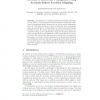Free Online Productivity Tools
i2Speak
i2Symbol
i2OCR
iTex2Img
iWeb2Print
iWeb2Shot
i2Type
iPdf2Split
iPdf2Merge
i2Bopomofo
i2Arabic
i2Style
i2Image
i2PDF
iLatex2Rtf
Sci2ools
HUC
2005
Springer
2005
Springer
A Study of Bluetooth Propagation Using Accurate Indoor Location Mapping
The ubiquitous computing community has widely researched the use of 802.11 for the purpose of location inference. Meanwhile, Bluetooth is increasingly widely deployed due to its low power consumption and cost. This paper describes a study of Bluetooth radio propagation using an accurate indoor location system to conduct fine-grained signal strength surveys. We discuss practical problems and requirements encountered setting up the infrastructure using the ultrasonic Active Bat indoor location system, and limitations of the commodity Bluetooth devices used. We conclude that Bluetooth is poorly suited to the purpose of fine-grained, low latency location inference due to specification and hardware limitations, and note that the movement speed of mobile devices is an important factor in calculating available bandwidth. We publish our data sets of signal strength samples for the community to freely use in future research.
| Added | 29 Jun 2010 |
| Updated | 29 Jun 2010 |
| Type | Conference |
| Year | 2005 |
| Where | HUC |
| Authors | Anil Madhavapeddy, Alastair Tse |
Comments (0)

